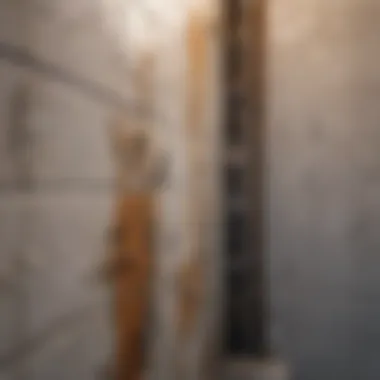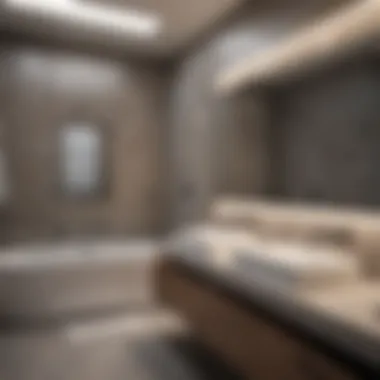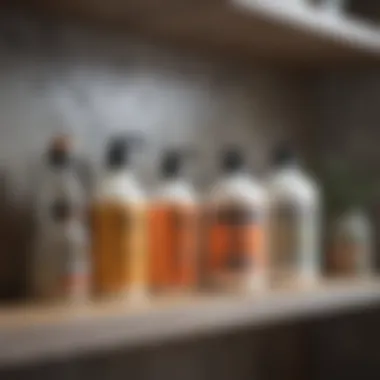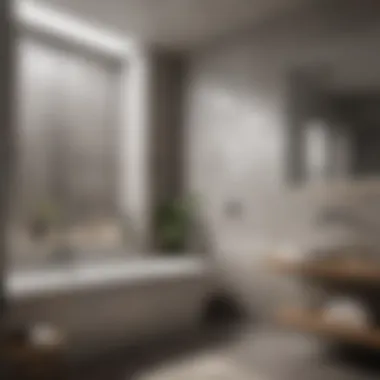Effective Bathroom Mold Removal Techniques


Intro
Mold in the bathroom is a common issue that can lead to serious health risks and damage to home interiors. Understanding the nature of mold, what causes it, and how to effectively remove it is essential for maintaining a safe and healthy living space. This comprehensive guide dives deep into the different strategies for bathroom mold removal, examining the various methods and products available to homeowners. By addressing the underlying causes of moisture accumulation, this guide ensures that readers not only eliminate existing mold but also prevent its recurrence.
Households often encounter a variety of mold types. These types can include black mold, which is notorious for its toxicity, and other molds that may not pose significant health risks but can still cause substantial damage. Recognizing these differences is vital for selecting the right removal strategy. An informed approach to bathroom maintenance extends beyond immediate fixes; it involves implementing long-term solutions that enhance the living space's overall health.
This article will explore effective mold removal steps, the products that can aid in this process, and preventive measures that are crucial for maintaining a mold-free environment. It will also touch on safety considerations for both homeowners and any professionals involved in mold remediation. Thus, whether one is dealing with a minor mold issue or preparing for a renovation, this guide offers valuable insights that are relevant and practical.
Preamble to Bathroom Mold
Understanding bathroom mold is crucial for any homeowner or individual concerned about maintaining a healthy living space. Mold growth in bathrooms is not just an aesthetic issue; it can lead to significant health risks and structural damage over time. Identifying what mold is, understanding its nature, and recognizing the potential dangers it poses are key steps in proactive home maintenance.
Defining Bathroom Mold
Bathroom mold refers to various species of fungi that thrive in damp environments, particularly in areas that are often exposed to moisture. Mold can appear in different colors, including black, green, yellow, or white, and tends to grow in bathroom spaces due to humidity and inadequate ventilation.
Identifying these fungi is essential, as some types can indicate more severe underlying issues within the bathroom's infrastructure. Removing visible mold is often just the first step; understanding its presence helps in preventing future outbreaks.
Health Risks Associated with Mold
The health implications of mold exposure can be significant, ranging from allergic reactions to severe respiratory problems. Common symptoms associated with mold exposure include:
- Sneezing and nasal congestion
- Coughing and throat irritation
- Skin irritation
- Eye irritation or redness
In some cases, prolonged exposure can cause more serious conditions, including chronic respiratory illnesses or compromised immune responses. Therefore, it is not just about aesthetics; maintaining a mold-free bathroom shields residents from various health threats.
"Effective management of bathroom mold is essential not only for the appearance of your home but also for the well-being of its occupants."
Being informed about bathroom mold, its definitions, and associated health risks empowers homeowners to take necessary precautions. This knowledge plays a significant role in ensuring a safe and clean bathroom environment.
Understanding Mold Growth
Understanding mold growth is crucial for effective bathroom mold removal. Mold thrives in environments that provide the right conditions. Without this knowledge, one might continually struggle with mold issues despite various cleaning efforts. This section aims to breakdown the necessary factors that lead to mold growth and how addressing them can create a healthier home environment.
Conditions that Favor Mold
Mold requires specific conditions to flourish. These include warmth, moisture, and organic materials to feed on. Here are some key conditions that promote mold growth in bathrooms:
- Humidity Levels: Mold spores prefer humid environments. A bathroom, with its frequent use of water, often becomes a perfect breeding ground. Keeping humidity levels above 60% can lead to mold proliferation.
- Warmth: Mold tends to thrive in warmer temperatures. Bathrooms, especially during and after hot showers, can reach optimal temperatures for mold growth.
- Poor Ventilation: Insufficient airflow creates stagnant air which holds moisture. This environment enables mold spores to settle and grow.
By addressing these conditions, homeowners can significantly reduce the likelihood of mold appearing and spreading.
Common Sources of Moisture in Bathrooms
Moisture is the primary catalyst for mold growth. It’s essential to identify where moisture builds up in bathrooms to effectively manage it. Below are common sources:
- Showers and Bathtubs: Water splashes, steam, and condensation create moist conditions that are ideal for mold.
- Toilets: Leaky toilets can contribute to persistent dampness. Even small leaks lead to moisture accumulation over time.
- Sinks: Running water or dripping faucets increases humidity. Any gaps or leaks under sinks can also lead to mold issues.
- Washing Machines: If your bathroom houses a washer, regular leaks or condensation from the appliance contribute to moisture.
"Identifying sources of moisture is half the battle in preventing mold growth. Once you know where moisture is coming from, you can take action to manage it effectively."
Identifying Types of Bathroom Mold


Identifying the types of mold present in your bathroom is crucial for effective removal and prevention strategies. Different molds have distinct characteristics, growth patterns, and health risks. Understanding these factors allows homeowners to implement targeted solutions that address specific types of mold. Moreover, it provides insights into the severity of the infestation, guiding decision-making on whether to tackle it personally or seek professional help. The consequences of not addressing mold issues can escalate, making it vital to differentiate between common types of mold.
Black Mold: Characteristics and Risks
Black mold, scientifically known as Stachybotrys chartarum, is often recognized for its dark appearance. This type of mold thrives in damp environments, especially when there’s a source of cellulose-based material, such as drywall or wood. One of the primary concerns surrounding black mold is its potential health risks. Exposure can lead to respiratory issues, allergic reactions, and other serious health complications.
Homeowners should be vigilant for the following signs indicating the presence of black mold:
- Dark greenish or black spots on surfaces.
- A musty odor that persists even after cleaning.
- Signs of water damage or previous leaks.
Removing black mold requires careful procedures and the use of protective gear. If extensive growth is detected, it is advisable to consult an expert.
Green Mold: when to be Concerned
Green mold typically refers to various species of mold that exhibit a green hue, such as Aspergillus and Penicillium. While some varieties may be less harmful, others can cause health issues. Respiratory problems, sinus infections, and allergic reactions are possible outcomes of exposure. Though not all green mold presents a significant health threat, it is essential to monitor its growth closely.
Indicators that may suggest the need for concern include:
- Rapid growth on surfaces, particularly in areas with high humidity.
- Discoloration of walls, ceilings, or grout.
- Presence of a damp or earthy smell.
If you notice these signs, it’s prudent to take action immediately before the problem worsens.
Other Common Types of Mold in Bathrooms
Apart from black and green mold, bathrooms can foster other varieties as well. Some common types include:
- White Mold: Often looks like a powdery substance and can indicate moisture issues. White mold needs to be addressed promptly to prevent extensive damage.
- Pink Mold (Serratia marcescens): Not a true mold but rather a bacterium that thrives in moist environments. It can leave pink stains on grout and fixtures.
- Fuzzy Mold: This may vary in color and texture but usually indicates a serious moisture problem.
Recognizing these types can help in taking proactive measures to maintain a mold-free environment.
"Taking the time to identify the specific type of mold not only aids in choosing proper removal techniques, but also improves overall safety in your home.”
In summary, identifying the types of bathroom mold is a vital step in mold management. As different molds present unique challenges and risks, being informed allows homeowners to make educated decisions.
Effective Mold Removal Techniques
Effective mold removal techniques are critical in the ongoing battle against bathroom mold. Bathrooms represent a unique environment, with high moisture levels that serve as a breeding ground for various types of mold. Knowing how to effectively and safely remove this mold is not just about aesthetics; it also contributes significantly to the health of inhabitants and the overall integrity of the home. Employing proper techniques can help ensure that mold does not return, while also maximizing the safety of both people and the spaces they occupy.
Chemical Cleaners: Pros and Cons
Chemical cleaners offer potent solutions for mold removal, often providing immediate results. These products are readily available and can effectively kill mold spores upon contact. Some common chemical cleaners include products that contain bleach or ammonium compounds.
Pros:
- They can work quickly to kill mold at the source.
- Easy to find in most stores and often come with user-friendly instructions.
- Many chemical cleaners have a long shelf life, making them convenient for storage.
Cons:
- They may release harmful fumes that can affect indoor air quality.
- Prolonged exposure can potentially lead to health risks, particularly for those with respiratory issues.
- Improper use can damage surfaces, such as tiles or painted walls, leading to additional repair costs.
Natural Alternatives: Safe Options


For those who prefer a less aggressive approach, natural alternatives provide safer options for mold removal. Many common household items can be effective in combating mold without the harsh side effects associated with chemical cleaners.
Some natural options are:
- Vinegar: A mild acid that can kill many types of mold spores. Spray undiluted white vinegar directly onto the affected areas and let it sit for a few hours before wiping off.
- Baking soda: A natural scrub that can be combined with vinegar. It effectively removes mold while neutralizing odors. Mix two tablespoons of baking soda with two cups of water and spray onto the moldy surface.
- Tea tree oil: Though more expensive than other options, tea tree oil is a powerful antifungal. Mix one teaspoon with one cup of water and spray on the affected area for a natural remedy.
These alternatives not only promote a healthier indoor environment but are also eco-friendly, keeping the space free from harmful chemicals.
Deep Cleaning Procedures
Deep cleaning involves a more thorough approach to mold removal that encompasses various techniques and tools to eradicate mold consistently. These procedures often require more time and effort but are essential to ensure long-term mold prevention.
Key steps in deep cleaning include:
- Remove and Clean: Take out any washable items such as shower curtains, towels, and bath mats. Wash them in hot water to kill any mold spores.
- Scrub surfaces: Use a scrub brush or sponge with natural or chemical solutions to clean tiles, grout, and other surfaces thoroughly. Ensure to pay special attention to corners and crevices where mold may hide.
- Dry the area: After scrubbing, it is vital to dry the cleaned surfaces quickly. Use a fan or dehumidifier aimed at the cleaned areas to reduce moisture levels.
- Seal surfaces: Applying a mold-resistant sealant on porous surfaces can provide extra protection against future growth.
Deep cleaning not only targets currently visible mold but also disrupts potential future growth by lowering moisture retention, thus enhancing overall bathroom hygiene.
Prevention of Bathroom Mold
Preventing bathroom mold is crucial for maintaining a healthy living environment. Mold not only affects the aesthetics of your space but also poses serious health risks. Regular prevention measures can significantly reduce the chance of mold proliferation. These approaches focus on limiting moisture, enhancing air circulation and ensuring consistent cleaning routines. By investing time and resources in prevention, homeowners can save themselves from the costly implications of mold remediation, which often involves professional help, extensive repairs, and potential health treatments.
Ventilation Solutions
Proper ventilation is one of the most effective methods for preventing mold growth in bathrooms. Good airflow helps to regulate humidity levels by allowing excess moisture to escape. Here are several strategies to improve ventilation:
- Install Exhaust Fans: A properly sized and installed exhaust fan can significantly reduce humidity levels. It is advisable to operate the fan during and after showers, ideally for at least 30 minutes to clear moisture from the air.
- Open Windows: When weather allows, opening windows helps increase fresh air circulation. It’s beneficial to create cross-ventilation by opening windows on opposite sides of the bathroom.
- Use Dehumidifiers: In spaces where humidity remains high, portable dehumidifiers can effectively lower moisture levels. This is particularly helpful in rooms without windows or exhaust systems.
"A well-ventilated bathroom is a primary defense against mold. Ensuring airflow can save you future headaches."
Humidity Control Measures
Maintaining appropriate humidity levels is key in mold prevention. Mold thrives in damp environments, so monitoring moisture levels can help mitigate the risks. Below are effective humidity control measures:
- Monitor Humidity Levels: Using a hygrometer helps track indoor humidity levels. Ideally, humidity should stay below 50% in bathrooms.
- Seal Cracks and Gaps: Inspect and seal any cracks, especially around windows and doors where moisture can enter. Using caulk can prevent additional water from seeping into the bathroom.
- Use Moisture-Resistant Products: Materials such as moisture-resistant drywall, paint, and flooring can resist mold growth and are advisable for bathroom use.
Regular Maintenance Tips
Routine maintenance is essential for preventing mold and maintaining a clean bathroom space. Consistency in cleaning and inspection can prevent mold from taking hold. Consider implementing the following tips:
- Consistent Cleaning: Regularly clean bathroom surfaces with appropriate cleaning products to eliminate mold spores before they develop into larger problems. Pay attention to tiles, grout, and behind the toilet.
- Check for Leaks: Regularly inspect plumbing fixtures and pipes. Address any leaks or condensation promptly to prevent water accumulation.
- Replace Shower Curtains and Liners: If shower curtains or liners show signs of mold or mildew, replace them immediately. Washing them frequently can also help keep them in a mold-free condition.
By adhering to these preventive measures, homeowners can significantly diminish the risk of mold in their bathrooms. Engaging in vigilance and proactive efforts fosters a healthier living space, avoiding the complications mold can introduce.
Keeping Your Bathroom Mold-Free
Maintaining a mold-free bathroom is not merely a matter of aesthetics; it is a fundamental aspect of ensuring a healthy living space. Mold thrives in moist, poorly ventilated environments, making bathrooms prime locations for growth. By implementing diligent cleaning routines and making informed choices on materials, homeowners can significantly reduce the risk of mold development.
Routine Cleaning Schedule
A consistent cleaning schedule is a cornerstone of mold prevention. Establishing a routine helps eliminate mold spores before they can establish themselves.


- Daily Maintenance: Wipe down surfaces, particularly around sinks, showers, and tubs, to remove excess moisture.
- Weekly Cleaning: Use appropriate cleaning solutions on tiles, grout, and other vulnerable areas.
- Monthly Deep Cleans: Address hidden areas like behind the toilet and under the sink. Use a combination of vinegar and baking soda for a natural approach that is both effective and non-toxic.
By following a regular cleaning schedule, families can greatly minimize the chance of mold infestation. It is also wise to involve all household members in this routine so that everyone understands the importance of upkeep.
Choosing the Right Materials
Selecting the right materials for your bathroom may seem trivial, but it plays a crucial role in mold prevention. Certain products naturally repel moisture or are more resistant to mold growth. Consider the following:
- Paint: Use moisture-resistant paint for walls and ceilings. Brands like Benjamin Moore offer specific formulations designed to deter mold.
- Tiles and Grout: Opt for non-porous tiles such as porcelain and ceramic, which do not absorb water easily. Grout should be sealed regularly to block moisture penetration.
- Fixtures: Choose bathroom fixtures made from materials that resist corrosion and rust, as these are less likely to harbor mold.
By being selective about materials, homeowners can create an inhospitable environment for mold to thrive.
Signs of Mold Reoccurrence
Even with preventive measures in place, it's essential to be vigilant about the signs of mold reoccurrence. Watch for these indicators:
- Visual Signs: Look for discoloration on walls, ceilings, or around fixtures. Early spotting can lead to quicker remediation.
- Musty Odor: A persistent, unpleasant smell often accompanies hidden mold. If a musty scent is detected, it may indicate a problem that warrants immediate attention.
- Condensation Buildup: Excessive condensation on bathroom surfaces can signal high humidity levels, which can lead to mold growth if not addressed.
Recognizing these signs early can facilitate prompt action, ensuring that mold does not become a larger issue than it needs to be.
Regular vigilance is key. The sooner homeowners identify potential mold problems, the easier it is to remain ahead of the issue.
By implementing a robust cleaning schedule, choosing suitable materials, and monitoring for signs of reoccurrence, homeowners can create a sustainable, mold-free bathroom environment.
When to Seek Professional Help
Understanding when to seek professional help is crucial in addressing bathroom mold issues effectively. Mold can spread quickly and, at times, can pose serious health risks. Homeowners often underestimate the severity of a mold infestation, thinking it is manageable with basic cleaning. However, there are instances where professional intervention is necessary to ensure safety and proper remediation. In this section, we will explore specific elements that highlight when it is time to call an expert.
Understanding the Scale of Mold Infestation
Assessing the extent of mold growth in one's bathroom is an essential step in determining whether to seek professional help. If you discover mold is extensive or hidden behind walls, it often indicates a more significant issue than surface cleaning can resolve. Key indicators include:
- Large Areas Affected: If the mold covers more than ten square feet, it is advisable to consult a professional.
- Chronic Water Issues: Persistent leaks or inadequate ventilation can lead to recurrent mold problems. An expert can evaluate and fix underlying issues.
- Multiple Types of Mold: Discovering various mold types may signal diverse sources of moisture. Professionals can accurately identify and treat these issues.
- Health Concerns: If inhabitants experience allergic reactions, respiratory issues, or other health concerns associated with mold exposure, seeking help is paramount.
Ultimately, professionals possess the tools and expertise needed to assess the situation thoroughly and execute effective solutions.
Choosing a Mold Remediation Professional
Selecting the right mold remediation professional is a significant decision that can affect the success of the mold removal process. Not all mold cleanup services are created equal, and certain factors should be taken into consideration:
- Certification and Experience: Verify that the professional holds relevant certifications, such as those from the Institute of Inspection, Cleaning, and Restoration Certification (IICRC). Their experience in mold remediation ensures they understand the complexities involved.
- Reviews and References: Look for reviews and testimonials from previous clients. A reputable professional will have positive feedback and be willing to provide references.
- Comprehensive Assessment: A good remediation expert conducts a thorough assessment of your property before providing an estimate. They should test the mold type and identify moisture sources.
- Clear Remediation Plan: Professionals should offer a detailed remediation plan that outlines the steps they will take, including containment, removal, and prevention of future mold growth.
- Insurance and Guarantees: Ensure the professional is insured and offers warranties for their work. This protects you as a homeowner and ensures a certain level of accountability.
In summary, knowing when to seek help and understanding the characteristics of a qualified professional are vital for effective mold management. Taking action promptly can lead to a safer and healthier living environment.
Culmination
The conclusion serves as a critical component of this article. It synthesizes the information presented, reinforcing its significance for homeowners seeking to maintain a clean and healthy bathroom environment. Controlling mold growth not only improves aesthetics but also enhances overall health. Mold can lead to allergic reactions and respiratory issues, making this topic vital for anyone's living space.
In this concluding section, we revisit the key points discussed throughout the article, providing a framework for actionable steps. This connection ties together various methods of mold removal, prevention strategies, and the importance of timely intervention. The subtle details noted herein reflect on the knowledge that prevention and removal can be approached both systematically and effectively.
Summary of Key Points
- Understanding bathroom mold types is essential before engaging in removal. Each type has unique characteristics and health risks linked to it.
- Moisture control is a primary factor in preventing mold. Recognizing common sources of moisture and taking active measures against them is critical for a lasting solution.
- Natural methods exist alongside chemical alternatives, offering homeowners a choice depending on their comfort and safety preferences.
- Regular cleaning and maintenance schedules are vital in keeping mold at bay, ensuring that environments remain healthy and inviting.
- Knowing when to seek professional help is equally important. Identifying the scale of mold infestation can prevent further complications.
Final Thoughts on Mold Management
Mold management involves a comprehensive approach aimed at both prevention and timely intervention. Homeowners should prioritize understanding their bathrooms as unique environments with specific needs. Employing techniques learned throughout this guide can transform a space from mold-prone to mold-resistant.
In closing, maintaining a mold-free bathroom is not just about cosmetics; it's about enhancing your quality of life. By adopting the strategies outlined in this article, individuals can cultivate healthier living spaces that reflect care and attentiveness to their environment.















